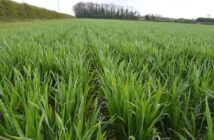Every year harvest results bring surprises; this year is no exception with wheat yields at surprisingly high levels on many farms, even with the late and protracted last phase of harvest.
These good yields generally and the breaking of the world wheat record with a yield of 16.5t/ha are thanks to the combination of favourable growing conditions says Dr Bob Bulmer, Hutchinsons trials and research manager.
“In our trials work, responses to disease control at 1.77t/ha have been slightly below the long term average, but this figure hides some significant variations from site to site. The average response to fungicide was 2.93t/ha at Ludlow in Shropshire and 0.86t/ha at the Badwell Ash site in Suffolk, which was one of the driest sites this year.”
“Septoria was the main disease at all of the sites, yellow rust was present at all of the sites, even Cornwall, but it only had a yield impact on the most susceptible varieties. The most noticeable feature of this season was that the response to the T1 fungicide was large – this is unusual and it reflects the declining curative effect of fungicide treatments.”
Group 1 and 2 results
Seeds manager Colin Button points out that growers have been encouraged to consider moving to produce high yields of more “quality wheats”, the Group 1 and 2 types, gaining more value and possibly accessing potential export markets as well.
“We are still waiting for the protein results from some of the nitrogen management plots and it will be interesting to see if it is possible to have both high yields and high protein levels. Producing yield and quality will be one of the aspects of crop management that we will be demonstrating in 2016.”
“Lili has shown itself to be a great choice for a range of situations, giving a consistent performance across different soil types and fertility as well as location. Indeed, it ranked in the top 5 varieties on 5/8 sites.”
“Anapolis, a Saaten Union feed wheat variety, has taken pole position in the average of all sites. As a result, it is a variety which we will feature more in 2016 and is ideal for later sowing after maize, for example.”
Mr Button adds that the variety Reflection is in joint lead on the AHDB results to date and was the variety used by Tim Lamyman in his 16.5t/ha yield performance in the Yield Enhancement Network (YEN) project.
“In reality, these facts all indicate high level performance, however please do bear in mind the straw length of Reflection is very short, which may not suit growers where wheat straw is a requirement and the short straw could also make this variety less competitive with black grass.”
Both men agree that the overall lesson is that getting the best from the site taking into account farm location, soil type and fertility, means attention to detail over your variety choice is worthwhile, and that variety selection should also be linked to the market for which you are growing.
“Talking to your market outlet, your agronomist and seed specialist will help you make the best decisions to suit your individual circumstances, “says Mr Button.



